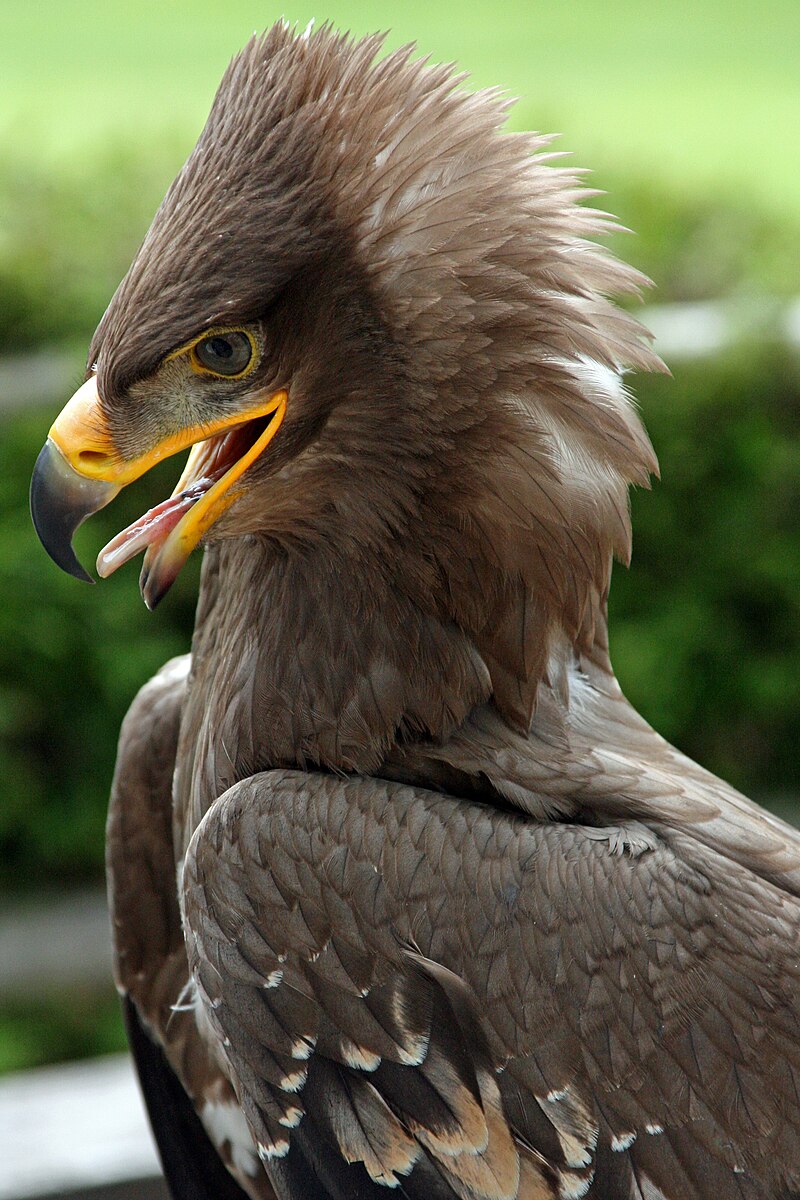Steppe eagles, like all birds, do not have teeth. Instead, they have a beak that serves as their primary tool for hunting and eating. The beak of a steppe eagle is strong and hooked, with a sharp point for tearing flesh.
The Beak of a Steppe Eagle
The beak of a steppe eagle is a crucial part of their anatomy, as it is their primary tool for hunting and eating. The beak is strong and hooked, with a sharp point that allows them to tear through the flesh of their prey. This design is well-suited for their diet, which consists primarily of small mammals, birds, reptiles, and carrion.
While some species of birds, such as those in the Falconidae family, have a protuberance on their beak called “teeth” that they use to break the cervical vertebrae of their prey, steppe eagles are not part of this family and do not have these “teeth” on their beaks.
Steppe Eagle Diet and Hunting Techniques
 Image source: Steppe Eagle by Fimb
Image source: Steppe Eagle by Fimb
Steppe eagles are known for their exceptional agility and efficient flight techniques, which allow them to conserve energy during their long migrations. They primarily feed on small mammals, birds, reptiles, and carrion, with ground squirrels making up a significant portion of their diet in some populations.
To hunt their prey, steppe eagles use a variety of techniques, including:
- Soaring: Steppe eagles are skilled at using thermal currents to soar high in the sky, allowing them to scan a large area for potential prey.
- Perching: Steppe eagles will often perch on high vantage points, such as trees or artificial structures, to watch for prey on the ground.
- Swooping: When they spot prey, steppe eagles will swoop down and use their sharp beak to capture and kill their target.
Nesting and Habitat of Steppe Eagles
Despite their preference for ground nests, steppe eagles have adapted to changing conditions by moving to raised platforms, such as bushes, trees, and artificial structures. This adaptability has allowed them to thrive in a variety of habitats, including grasslands, steppes, and semi-desert regions.
Steppe eagles are known to migrate long distances, with some populations traveling thousands of kilometers between their breeding and wintering grounds. During these migrations, they rely on their exceptional flight skills and efficient use of thermal currents to conserve energy and reach their destination.
Conservation Status of Steppe Eagles
The steppe eagle is classified as “Endangered” on the IUCN Red List of Threatened Species. This is due to a variety of threats, including habitat loss, hunting, and poisoning. Conservation efforts are underway to protect these majestic birds and ensure their continued survival.
One of the key conservation strategies for steppe eagles is the protection and restoration of their natural habitats. This includes measures to prevent overgrazing, reduce the use of pesticides, and promote sustainable land management practices. Additionally, efforts are being made to reduce the illegal hunting and trade of steppe eagles, as well as to mitigate the impact of power lines and other infrastructure on their populations.
Conclusion
In conclusion, while steppe eagles do not have teeth, they have a strong and hooked beak that serves as their primary tool for hunting and eating. Their beak is not equipped with the “teeth” found in some other bird species, but it is well-suited for their diet and hunting techniques. Conservation efforts are underway to protect these majestic birds and ensure their continued survival in the face of various threats.
References:
– Fact Animal – Steppe Eagle
– Oltremare – The Stars: Birds of Prey
– Fact Animal – Largest Eagles in the World by Wingspan
– LinkedIn Post – Magdy Hassan
– Science Trek – Birds of Prey

